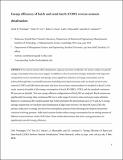Energy efficiency of batch and semi-batch (CCRO) reverse osmosis desalination
Author(s)
Maswadeh, Laith A.; Warsinger, David Elan Martin; Tow, Emily W.; Nayar, Kishor Govind; Lienhard, John H
DownloadCCRO with tank journal paper v116 Preprint.pdf (374.0Kb)
OPEN_ACCESS_POLICY
Open Access Policy
Creative Commons Attribution-Noncommercial-Share Alike
Terms of use
Metadata
Show full item recordAbstract
As reverse osmosis (RO) desalination capacity increases worldwide, the need to reduce its specific energy consumption becomes more urgent. In addition to the incremental changes attainable with improved components such as membranes and pumps, more significant reduction of energy consumption can be achieved through time-varying RO processes including semi-batch processes such as closed-circuit reverse osmosis (CCRO) and fully-batch processes that have not yet been commercialized or modelled in detail. In this study, numerical models of the energy consumption of batch RO (BRO), CCRO, and the standard continuous RO process are detailed. Two new energy-efficient configurations of batch RO are analyzed. Batch systems use significantly less energy than continuous RO over a wide range of recovery ratios and source water salinities. Relative to continuous RO, models predict that CCRO and batch RO demonstrate up to 37% and 64% energy savings, respectively, for brackish water desalination at high water recovery. For batch RO and CCRO, the primary reductions in energy use stem from atmospheric pressure brine discharge and reduced streamwise variation in driving pressure. Fully-batch systems further reduce energy consumption by not mixing streams of different concentrations, which CCRO does. These results demonstrate that time-varying processes can significantly raise RO energy efficiency.
Date issued
2016-09Department
Massachusetts Institute of Technology. Department of Mechanical Engineering; Rohsenow Kendall Heat Transfer Laboratory (Massachusetts Institute of Technology)Journal
Water Research
Publisher
Elsevier
Citation
Warsinger, David M., Emily W. Tow, Kishor G. Nayar, Laith A. Maswadeh, and John H. Lienhard V. “Energy Efficiency of Batch and Semi-Batch (CCRO) Reverse Osmosis Desalination.” Water Research 106 (December 2016): 272-282.
Version: Author's final manuscript
ISSN
00431354